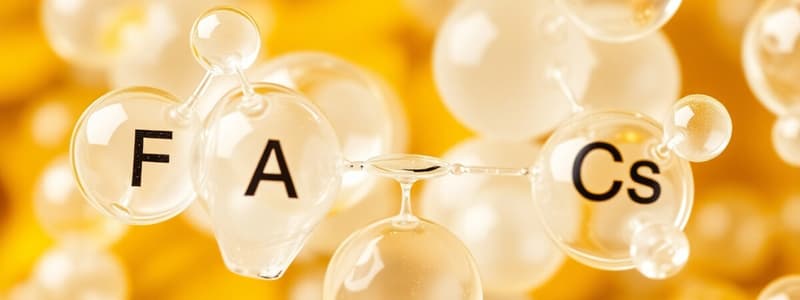Podcast
Questions and Answers
Which characteristic is common to all complex lipids?
Which characteristic is common to all complex lipids?
- Composed solely of fatty acids and alcohols
- Insolubility in water, relative solubility in organic solvents (correct)
- Presence of only two chemical identities
- Solubility in polar solvents
What is the primary distinction between fats and lipids?
What is the primary distinction between fats and lipids?
- Lipids are saturated, whereas fats are unsaturated.
- Fats include fatty acids, while lipids are only triglycerides.
- Fats are exclusively triglycerides, while lipids encompass a broader range including fatty acids, phospholipids, and sterols. (correct)
- Fats are solid at room temperature and lipids are liquid.
How does cholesterol contribute to membrane structure?
How does cholesterol contribute to membrane structure?
- By exclusively interacting with the polar head groups of phospholipids.
- By increasing membrane fluidity through repulsion of phospholipid tails.
- By interacting with polar head groups and nonpolar fatty-acid chains to increase membrane packing and reduce fluidity. (correct)
- By forming a rigid barrier that prevents any movement within the membrane.
What is the role of bile acids in the body?
What is the role of bile acids in the body?
Where are primary bile acids synthesized?
Where are primary bile acids synthesized?
What structural feature characterizes bile salts?
What structural feature characterizes bile salts?
Which of the following properties is characteristic of fatty acids?
Which of the following properties is characteristic of fatty acids?
Which statement accurately describes the relationship between fatty acids and detergents?
Which statement accurately describes the relationship between fatty acids and detergents?
A biochemist is studying the hydrogenation of oils. What is the most likely purpose of this process?
A biochemist is studying the hydrogenation of oils. What is the most likely purpose of this process?
Which statement accurately describes the effect of dietary trans fatty acids on health?
Which statement accurately describes the effect of dietary trans fatty acids on health?
Why must essential fatty acids (EFAs) be included in the diet?
Why must essential fatty acids (EFAs) be included in the diet?
What primary role does docosahexaenoic acid (DHA) play in human health?
What primary role does docosahexaenoic acid (DHA) play in human health?
Which of the following is a key characteristic of 'cis' fatty acids?
Which of the following is a key characteristic of 'cis' fatty acids?
How does the configuration of a fatty acid (cis vs. trans) affect its physical properties?
How does the configuration of a fatty acid (cis vs. trans) affect its physical properties?
Which of the following best describes the role of eicosanoids in the body?
Which of the following best describes the role of eicosanoids in the body?
An individual is experiencing increased blood clotting. Which type of eicosanoid is most likely elevated in their system?
An individual is experiencing increased blood clotting. Which type of eicosanoid is most likely elevated in their system?
What outcome is most closely related to the activity of leukotrienes?
What outcome is most closely related to the activity of leukotrienes?
Which of the following is a function of prostaglandins?
Which of the following is a function of prostaglandins?
Which of the following features is common to arachidonic acid (AA), eicosapentaenoic acid (EPA), and dihomo-gamma-linolenic acid (DGLA)?
Which of the following features is common to arachidonic acid (AA), eicosapentaenoic acid (EPA), and dihomo-gamma-linolenic acid (DGLA)?
Which of the following best describes how oleic acid and elaidic acid are related?
Which of the following best describes how oleic acid and elaidic acid are related?
Where can Docosahexaenoic acid (DHA) be found in the body and how is it acquired?
Where can Docosahexaenoic acid (DHA) be found in the body and how is it acquired?
In complex lipids, which component is characteristic of phospholipids?
In complex lipids, which component is characteristic of phospholipids?
Consider a lipid sample that is found floating on water, feels greasy to the touch, and does not readily dissolve in water. How would you classify this lipid?
Consider a lipid sample that is found floating on water, feels greasy to the touch, and does not readily dissolve in water. How would you classify this lipid?
If a scientist is investigating a lipid that burns without leaving any residue, which type of lipid is the scientist most likely studying?
If a scientist is investigating a lipid that burns without leaving any residue, which type of lipid is the scientist most likely studying?
A researcher observes that increasing the number of carbon atoms in the chain of a saturated fatty acid also elevates its melting point. Which property of saturated fatty acids explains this?
A researcher observes that increasing the number of carbon atoms in the chain of a saturated fatty acid also elevates its melting point. Which property of saturated fatty acids explains this?
What is the role of glycerol in forming triglycerides?
What is the role of glycerol in forming triglycerides?
Which type of fatty acids would primarily contribute to increased membrane fluidity at lower temperatures in a cell membrane?
Which type of fatty acids would primarily contribute to increased membrane fluidity at lower temperatures in a cell membrane?
How would you classify alcohols contained in lipid molecules?
How would you classify alcohols contained in lipid molecules?
Which of the following is the most accurate definition of Glycerolipids?
Which of the following is the most accurate definition of Glycerolipids?
Which of the following are bile acids derived from?
Which of the following are bile acids derived from?
Flashcards
What are lipids?
What are lipids?
A diverse group of molecules, mainly composed of hydrocarbon chains. Essential for life, they include fats, oils, waxes, and steroids.
What are fatty acids?
What are fatty acids?
A class of lipids made of hydrocarbon chains terminated with a carboxylic acid group. These can be saturated or unsaturated.
What is a saturated fatty acid?
What is a saturated fatty acid?
A fatty acid where all carbon atoms are single-bonded to hydrogen.
What is an unsaturated fatty acid?
What is an unsaturated fatty acid?
Signup and view all the flashcards
What are Geometric Isomers?
What are Geometric Isomers?
Signup and view all the flashcards
What is 'cis' configuration?
What is 'cis' configuration?
Signup and view all the flashcards
What is 'trans' configuration?
What is 'trans' configuration?
Signup and view all the flashcards
Melting Point of Fatty Acids
Melting Point of Fatty Acids
Signup and view all the flashcards
Solubility of Fatty Acids
Solubility of Fatty Acids
Signup and view all the flashcards
What is the formation of detergents?
What is the formation of detergents?
Signup and view all the flashcards
What is the formation of esters?
What is the formation of esters?
Signup and view all the flashcards
What are eicosanoids?
What are eicosanoids?
Signup and view all the flashcards
What is Eicosapentaenoic acid (EPA)?
What is Eicosapentaenoic acid (EPA)?
Signup and view all the flashcards
What is Arachidonic acid (AA)?
What is Arachidonic acid (AA)?
Signup and view all the flashcards
What is Dihomo-gamma-linolenic acid (DGLA)?
What is Dihomo-gamma-linolenic acid (DGLA)?
Signup and view all the flashcards
What are Prostaglandins?
What are Prostaglandins?
Signup and view all the flashcards
What are Thromboxanes?
What are Thromboxanes?
Signup and view all the flashcards
What are Leukotrienes?
What are Leukotrienes?
Signup and view all the flashcards
What is Hydrogenation?
What is Hydrogenation?
Signup and view all the flashcards
What is Oxidation in lipids?
What is Oxidation in lipids?
Signup and view all the flashcards
What is Rancidity?
What is Rancidity?
Signup and view all the flashcards
What are essential fatty acids (EFAs)
What are essential fatty acids (EFAs)
Signup and view all the flashcards
What is Docosahexaenoic acid (DHA)?
What is Docosahexaenoic acid (DHA)?
Signup and view all the flashcards
What are Alcohols in lipids?
What are Alcohols in lipids?
Signup and view all the flashcards
What is Glycerol?
What is Glycerol?
Signup and view all the flashcards
What are Phospholipids?
What are Phospholipids?
Signup and view all the flashcards
What are Glycolipids?
What are Glycolipids?
Signup and view all the flashcards
lipoamino acids
lipoamino acids
Signup and view all the flashcards
Functions of cholesterol
Functions of cholesterol
Signup and view all the flashcards
Cholesterol Interactions
Cholesterol Interactions
Signup and view all the flashcards
What are bile acids?
What are bile acids?
Signup and view all the flashcards
Secretion of Bile Acids
Secretion of Bile Acids
Signup and view all the flashcards
Study Notes
Classification of Lipids
- Lipids are divided into eight categories, including fatty acids, glycerolipids, glycerophospholipids, sterol lipids, prenol lipids, sphingolipids, saccharolipids, and polyketides.
Fatty Acids Composition
- Fatty acids consist of a hydrocarbon chain with a carboxylic acid group at the end.
- Fatty acids have two ends: a polar (hydrophilic) end, and a nonpolar (hydrophobic) one
- Length typically ranges between 4 and 24 carbons.
- They can be saturated or unsaturated.
- Fatty acids may have functional groups containing oxygen, halogens, nitrogen, and sulfur.
Cis and Trans Configuration
- Fatty acids which contain a double bond can be in a cis or trans configuration
- cis configuration: functional groups are on the same side of the carbon chain
- trans configuration: functional groups are on opposing sides of the carbon chain
- Most natural fatty acids have a cis configuration.
- trans fats and oils have higher melting points than cis fats because their packing is not affected as much.
- Naturally occurring unsaturated fats and oils tend to be in the cis form.
- Eicosanoids are biologically important fatty acids that mediate inflammation, tissue homeostasis, and blood clotting
Isomerism
- Two types of isomers can occur in an unsaturated fatty acid: geometric isomers.
- Geometric Isomers depend on the orientation of the radicals around the axis of the double bonds.
- 'cis' form: the H are on the same side of the bond
- 'trans' form: the H are on the opposite side
- 'Cis' form is comparatively unstable and more reactive.
- Oleic acid and elaidic acid have the same molecular formula: C17H33COOH.
Common Properties of Lipids
- Lipids float on water
- Lipids are insoluble in water
- Lipids are greasy to the touch and lubricating
- Lipids are not readily volatile
- Lipids burn without leaving residue
- Lipids have low density, melting points, and boiling points
Physical Properties of Fatty Acids
- The melting point of saturated fatty acids increases with carbon atoms in the chain.
- Butyric acid has a MP of 8°C, Palmitic acid's MP is 62°C, and Stearic acid shows 70°C.
- Higher saturation and increased chain length result in a higher melting point.
- Fatty acid solubility increases with each double bond.
- The solubility decreases with increased chain length because Methylene groups increase
Chemical Properties of Fatty Acids
- Fatty acids form salts with alkali and alkaline earth metals producing salts of Na, K, Ca and Mg, which are soaps
- Sodium and potassium salts are soluble; calcium and magnesium salts are insoluble.
- Reduction of COOH in fatty acids produces alkyl alcohols, sulfated into alkyl sulfates as detergents.
- Fatty acids combine with alcohol to form esters like mono-, di-, and tri-glycerides.
Eicosanoids
- Eicosanoid is a collective term for oxygenated derivatives of 20-carbon fatty acids
- Eicosapentaenoic acid (EPA) is an ω-3 fatty acid with 5 double bonds.
- Arachidonic acid (AA) is an ω-6 fatty acid with 4 double bonds.
- Dihomo-gamma-linolenic acid (DGLA) is an ω-6 fatty acid with 3 double bonds.
- Oxidation of 20-carbon fatty acids created signalling molecules
Eicosapentaenoic acid (EPA)
- Omega-3 fatty acid found in fish oils, benefiting heart health, eases blood flow, reduces triglycerides, pain, and swelling.
Arachidonic acid (AA)
- Polyunsaturated omega-6 fatty acid; if the diet contains linoleic acid, AA forms to create leukotrienes, prostaglandins, and thromboxanes
Dihomo-y-linolenic acid (DGLA)
- 20-carbon carboxylic ω-6 fatty acid, helps the immune system, prevents depressions, and develops nervous system in infants
Formation of Eicosanoids
- Eicosanoids involve prostaglandins and related compounds derived from arachidonic acid, a 20-carbon polyunsaturated fatty acid.
- Three classes: prostaglandins, thromboxanes, and leukotrienes.
- Prostaglandins: hormone-like compounds that affect Blood clotting, Inflammation, Menstruation, Labor, and Tissue damage.
- Thromboxanes: Lipids produced by platelets and endothelial cells that are involved with blood clotting, vasoconstriction, and platelet aggregation.
- Leukotrienes: inflammatory mediators produced by leukocytes, involved in asthma, allergic inflammation, and innate immunity
Biological processes Regulated by Eicosanoids
- Blood clotting is regulated by thromboxane A2 constricting blood vessels and platelet aggregation and prostacyclin dilating blood vessels and inhibiting platelet aggregation.
- Inflammatory response is mediated by prostaglandins
- Reproductive system is stimulated by smooth muscle by PGE2
- Gastrointestinal tract is aided by prostaglandins inhibiting gastric secretion, and Prostaglandins increasing secretion of protective mucus.
- Kidneys function by prostaglandins dilating renal blood vessels which results in increased water and electrolyte excretion
- Respiratory tract which leukotrienes promote the constriction of bronchi while prostaglandins promote bronchodilation
Chemical Properties of Lipids
- Hydrogenation: saturates double bonds in oils by adding hydrogen (hardening of oils).
- Halogenation: unsaturates double bonds in fatty acids (F, I, and Br halogens).
- Iodine Number: grams of iodine double bonds in 100 grams of fat
Lipid Oxidation
- Double bonds in unsaturated fatty acids are oxidizable.
- Spontaneous oxidation forms transparent coating on a surface, used in paint manufacturing.
Chemical Properties - Rancidity
- Rancidity occurs the oxygen in air affects lipid-rich foods by spoiling
- The unpleasant taste and smell is caused by oxidative cleavage of double bonds, thus volatility increases.
Improving Shelf Life
- Improves the shelf life of commercial vegetable oils used by employing partial hydrogenation to enhance stability.
- Converts cis double bonds into saturated single bonds, increasing oils melting point
Undesirable Hydrogenation
- Partial hydrogenation converts cis double bonds to trans double bonds.
- Dietary trans fatty acids raise triacylglycerols and LDL, lowering HDL, elevating coronary heart disease risk.
Essential Fatty Acids
- Polyunsaturated fatty acids that consist of linoleic acid, linolenic acid and arachidonic acid.
- They cannot be produced by the body and must be obtained through diet.
- EFA deficiency results in growth retardation and deficiency symptoms.
Docosahexaenoic Acid (DHA)
- Polyunsaturated fatty acid synthesized from α-linolenic acid or from fish oil.
- Concentrations in retina, cerebral cortex, testes, and sperm, needed for brain development via placenta and breast milk
Alcohols
- Glycerol, cholesterol, and higher alcohols (e.g., cetylalcohol)
- Glycerol is called glycerin, simplest trihydric alcohol with hydroxyl groups in molecule
Complex Lipids
- Complex lipids are divided into three subgroups: phospholipids, glycolipids, and lipoamino acids.
- Phospholipids: have a phosphorous base, found in the brain and include lecithin, cephalin and sphingomyelin.
- Glycolipids: consist of long-chain sugar derivatives with base of gylcerol in plants & bacteria or a ceramide in animals.
- Lipoamino acids: amino acids, linked into a long-chain alcohol and glycerolipid
Characteristics of Complex Lipids:
- They’re generally insoluble in water, but soluble in organic solvents.
- They present polar properties and include chemicals with fatty acids, alcohols, phosphates, and nitrogenous bases.
Fats vs Lipids
- Fats are triglycerides
- Lipids include fatty acids, phospholipids, cholesterols, sphingolipids, vitamin A, D, etc.
Fats vs Oil
- Fats are solid at room temperature, and are saturated.
- Oils are liquid at room temperature and are unsaturated.
Cholesterol Function
- Required for membranes construction & maintenance via hydroxyl group interaction with polar membrane phospholipids/sphingolipids and bulky hydrocarbon chain embedded in membrane like other lipids.
- Cholesterol increases membrane packing and reduces membrane fluidity via fatty-acid chains
Bile Acids
- Steroid acids dominant in mammals & other vertebrates bile.
- Bile Salts are bile acids with positive ions, usually sodium.
- Primary bile acids are synthesized by the liver
- Secondary bile acids come from bacterial activity in the colon.
- In humans, taurocholic & glycocholic acid (cholic acid derivatives) & taurochenodeoxycholic & glycochenodeoxycholic acid (chenodeoxycholic acid derivatives) make approx 80% of bile salts
- Conjugated salts also found in human bile include 7-alpha dehydroxylated derivatives, deoxycholic, lithocholic acid
Bile Self Study
- Bile contains 80% organic compounds (with phospholipids & cholesterol)
- Increased secretion increases bile flow
- Aids micelles formation for digestion, fat absorption, plus hormonal effects.
- Bile salts include five/eight-carbon side-chain steroid w/ four rings ending in carboxylic acid & hydroxyl groups.
Studying That Suits You
Use AI to generate personalized quizzes and flashcards to suit your learning preferences.




